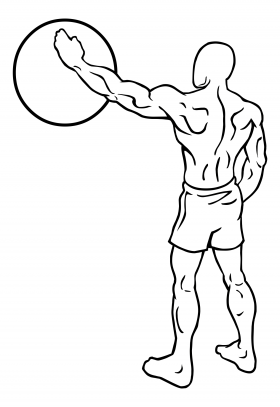Note: Part 2 of this article is geared more toward a qualified healthcare practitioner.
Full return to throwing and contact sports occurs in 80-90% of athletes. Successful return to sport and activity is dependent on following post-surgical precautions and completing a structured post-surgical rehabilitation program. The rehabilitation program we use at Back to Function is a combination of evidence-based protocols and our own experience and clinical decision making. 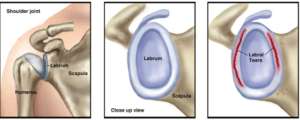 General time frames are presented, but individuals will progress at different rates depending on age, associated injuries, health status, rehabilitation compliance and injury severity.
General time frames are presented, but individuals will progress at different rates depending on age, associated injuries, health status, rehabilitation compliance and injury severity.
Phase 0: 0-1 week after surgery
Goals:
- control pain and swelling
- protect the repair
- begin early shoulder motion
Activities:
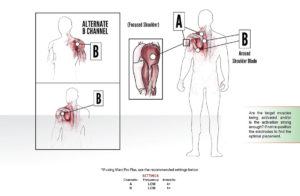 Use electrotherapy such as the MarcPro to reduce pain and swelling.
Use electrotherapy such as the MarcPro to reduce pain and swelling.- Remove sling to move your elbow, fingers and hand at least 5 times per day. Wear sling all other times including sleeping.
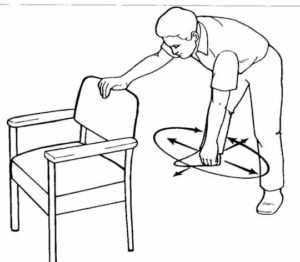 Pendulum exercise-bend over at waist and let the surgical side arm hang down. Using your body to initiate movement, swing the arm gently in small circular motions for 1-2 minutes each direction for 5+ sets per day.
Pendulum exercise-bend over at waist and let the surgical side arm hang down. Using your body to initiate movement, swing the arm gently in small circular motions for 1-2 minutes each direction for 5+ sets per day.- Remove the outer dressing on the 2nd day after surgery and shower. Leave the steri-strips in place. You can get the wound wet after 2 days in a shower, but DO NOT soak in a tub. To wash under the operated arm, bend over at waist and let the arm passively swing away from body (similar to Pendulum exercise).
- Use of the surgical arm-keep your elbow slightly in front of body. DO NOT reach behind your body. When putting on clothing, lean forward and pull the shirt up and over the surgical arm first. Then put the other arm into the opposite sleeve. To remove a shirt, take the non-surgical arm out of the sleeve first, and then slip the shirt off the surgical arm.
- Notify your surgeon’s office immediately if you have severe pain, fevers or chills or start to have an elevated body temperature.
Typically you will see your surgeon 10 days after the surgery for an examination.
Phase 1: 1-4 weeks after surgery
Goals:
- protect surgical repair
- ensure wound healing
- prevent shoulder stiffness (frozen shoulder)
- regain range of motion
- control pain and swelling
Activities:
- Use electrotherapy such as the MarcPro to reduce pain and swelling.
- Remove sling to move your elbow, fingers and hand at least 5 times per day. Wear sling all other times including sleeping.
- Pendulum exercise-bend over at waist and let the surgical side arm hang down. Using your body to initiate movement, swing the arm gently in small circular motions for 1-2 minutes each direction for 5+ sets per day.
- Showering-DO NOT soak in a tub. To wash under the operated arm, bend over at waist and let the arm passively swing away from body (similar to Pendulum exercise).
- Use of the surgical arm-you may use your hand in front of your body but DO NOT raise your arm overhead. Avoid extending the arm behind you and avoid putting your arm in a position as if your hands were behind your head. It is OK for you to flex your arm at the elbow but DO NOT lift any objects heavier than 2 lbs or engage in activities that involve forceful use of the forearm such as using a screwdriver. Use of a computer and writing is OK as long as it is not painful.
- Therapy treatment-soft tissue of anterior chest, posterior shoulder, neck, arm, forearm and hand 3-5 times per week. Passive shoulder flexion as tolerated, weeks 0-2 –> 40 degrees of abduction, 0-15 degrees of external rotation (ER) and 0-45 degrees of internal rotation (IR), weeks 3-4 –> 80 degrees of abduction, 30 degrees of ER, 60 degrees of IR. Avoid excessive shoulder extension and ER in abduction. Chiropractic manipulative therapy (CMT) as needed.
- ROM Exercises-
- Supine passive arm elevation within pain tolerance
- Shoulder shrug and shoulder blade retraction
- Ball squeezes
- Standing isometric internal & external rotation at 0 degrees abduction
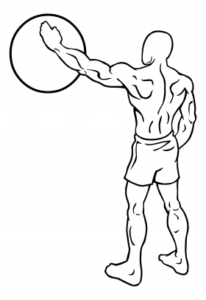 Rhythmic stabilization supine or standing with Pball against wall
Rhythmic stabilization supine or standing with Pball against wall- Supine ER with stick at 0 degrees abduction
- Behind the back opposite hand assisted IR
- Cardiovascular Exercises-
- Walking sling on
- Stationary bike sling on
- No Treadmill, no running, no arm bike, no swimming
Phase 2: 5-7 weeks after surgery
Goals:
- protect surgical repair
- improve range of motion
- begin strengthening
Activities:
- Use electrotherapy such as the MarcPro to reduce pain and swelling as needed.
- Sling should no longer be necessary.
- Showering-DO NOT soak in a tub. To wash under the operated arm, bend over at waist and let the arm passively swing away from body (similar to Pendulum exercise).
- Use of the surgical arm-you can now move your arm for most daily activities. Avoid extending the arm behind you and avoid putting your arm in a position as if your hands were behind your head. It is OK for you to flex your arm at the elbow but DO NOT lift any objects heavier than 2 lbs or engage in activities that involve forceful use of the forearm such as using a screwdriver. Use of a computer and writing is OK as long as it is not painful.
- Therapy treatment-soft tissue of anterior chest, entire shoulder, neck, arm, forearm and hand 3-5 times per week. Shoulder flexion as tolerated, shoulder abduction as tolerated, 45 degrees of ER, 60 degrees of IR in more or an abducted position. Chiropractic manipulative therapy (CMT) as needed.
- ROM Exercises-
- Pendulum exercise
- Supine passive arm elevation within pain tolerance
- Standing isometric internal & external rotation at 0 degrees abduction
- Rhythmic stabilization supine or standing with Pball against wall
- Supine ER with stick at 0 degrees abduction
- Behind the back opposite hand assisted IR
- Standing ER in doorway
- Standing forward elevation
- Standing lat stretch
- Strengthening Exercises-
- Tband or cable ER & IR
- Standing forward flexion
- Prone row
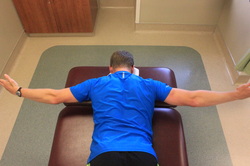 Prone horizontal abduction (T’s)
Prone horizontal abduction (T’s)- Prone extension
- Side lying ER
- Supine scapular protraction/retraction
- Standing serratus squat
- Cardiovascular Exercises-
- Walking
- Stationary bike
- No Treadmill, no running, no arm bike, no swimming
Phase 3: 8-12 weeks after surgery
Goals:
- protect surgical repair
- regain full range of motion
- strengthening progression
Activities:
- Use of the surgical arm-you may now safely use the arm for normal daily activities involved with dressing. bathing and self-care. You may raise the arm away from the body; however, you should not raise the arm when carrying objects greater than 1 lb. Any forceful pushing or pulling activities could still disrupt the healing of your surgical repair (example: dog pulls on leash).
- Therapy treatment-soft tissue of anterior chest, entire shoulder, neck, arm, forearm and hand 3-5 times per week. Shoulder flexion and abduction to 180 degrees, 90 degrees of ER, 90 degrees of IR in 90 degree abducted position. Chiropractic manipulative therapy (CMT) as needed.
- ROM Exercises-
- Pendulum exercise
- Rhythmic stabilization supine or standing with Pball against wall
- Wall slide stretch
- Supine cross-chest stretch
- Behind the back opposite hand assisted IR
- Standing ER in doorway
- Standing forward elevation
- Sidelying IR stretch (sleeper stretch)
- Supine ER at 90 degrees abduction with stick
- Hands behind the head stretch (week 9)
- Scapular pivots (week 9)
- Pball extension stretch
- PNF diagonals (Waiter to Knight/Shield to Fend-Off)
- Strengthening Exercises-
- Tband or cable ER/IR/forward punch/shrug/dynamic hug/W’s
- Tband or cable biceps curl (week 9)
- Tband or cable seated row (week 11)
- Standing forward flexion
- Prone row
- Prone horizontal abduction (T’s)
- Prone extension
- Prone scaption (Y’s)
- Side lying ER
- Supine scapular protraction/retraction
- Supine triceps extensions
- Standing serratus squat
- All ‘s with scapular integration
- Cardiovascular Exercises-
- Walking
- Stationary bike
- Stairmaster
- Running
- No swimming
Phase 4: 12-16 weeks after surgery
Goals:
- gradual initiation of functional activities
- maintain full range of motion
- strengthening progression
Activities:
- Therapy treatment-soft tissue and CMT as needed.
- ROM Exercises-
- Pendulum exercise
- Wall slide stretch
- Supine cross-chest stretch
- Behind the back opposite hand assisted IR
- Standing ER in doorway
- Standing forward elevation
- Sidelying IR stretch (sleeper stretch)
- Supine ER at 90 degrees abduction with stick
- Hands behind the head stretch
- Scapular pivots
- Pball extension stretch
- PNF diagonals
- Strengthening Exercises-
- Tband or cable ER/IR/forward punch/shrug/dynamic hug/W’s/T’s
- Tband or cable biceps curl/seated row/ER & IR at 90 degrees
- Tband or cable diagonal ups and downs
- Standing forward flexion
- Prone row
- Prone horizontal abduction (T’s)
- Prone extension
- Prone scaption (Y’s)
- Side lying side/ER/X-body raise
- Supine scapular protraction/retraction
- Standing triceps extensions
- Standing serratus squat
- All ‘s with scapular integration
- Prone ER at 90 degrees abduction (U’s)
- Resisted forearm supination/pronation & wrist flexion/ext
- PNF diagonals w/ manual resistance
- Long seated supported press downs
- All-4 belly lift reach
- Push ups
- Rebounder throws with arm at side
- Wall dribbles overhead
- Side planks
- 1-legged pitchers
- Weight Training-it is usually safe to return to weight training at 3 months following labrum repair. You should have full ROM of shoulder and normal strength in the rotator cuff and scapular muscles. The following exercises should be modified:
- Pull downs-only pull down in front of body to chest with a medium grip
- Bench press-use a narrow grip
- Lateral deltoid raises-thumb up position to avoid impingement
- Chest fly-keep elbows bent
- Pec deck-do not allow weights to stretch shoulders
- Dips-do not lower to or past 90 degrees
- Upright row-do not do!
- Cardiovascular Exercises-
- Walking
- Stationary bike
- Stairmaster
- Running
- No swimming
Phase 5: 16-20 weeks after surgery
Goals:
- progression of functional activities
- maintain full range of motion
- strengthening progression
Activities:
- Therapy treatment-soft tissue and CMT as needed.
- ROM Exercises-continue all exercises from phase 4
- Strengthening Exercises-continue all exercises from phase 4
- Rebounder throwing with weighted ball
- Deceleration drills with weighted ball
- Wall dribbles at 90 degrees
- Wall dribble circles
- Weight Training-see precautions in phase 4
- Sports Specific Programs
- Cardiovascular Exercises-no limitations
This protocol has been adapted from a few different sources cited below. It is intended to provide a guideline of the post-operative rehabilitation course of a patient that has undergone an arthroscopic labrum repair. It is by no means intended to be a substitute for clinical decision making regarding the patient’s own individual progression and/or the presence of post-operative complications.
If you have a shoulder issue that needs to be evaluated, please give us a call at 310-534-1900 or email us at info@backtofunction.com.
References:
Massachusetts General Hospital,Sports Physical Therapy Program. Shoulder Exercises for SLAP Rehabilitation Protocol.
Brigham and Women’s Hospital, Department of Rehabilitation Services. Arthroscopic Labral Repair Protocol-Type II, IV and Complex Tears.
University of Wisconsin Sports Medicine. Rehabilitation Guidelines for SLAP Lesion Repair.


